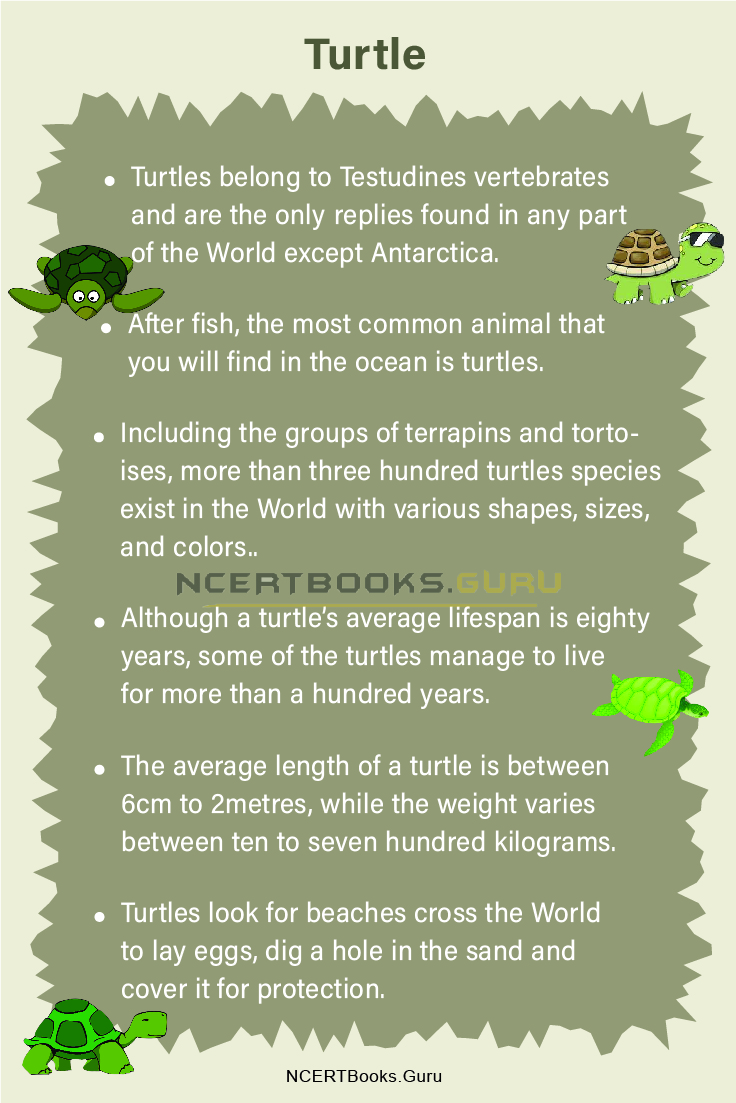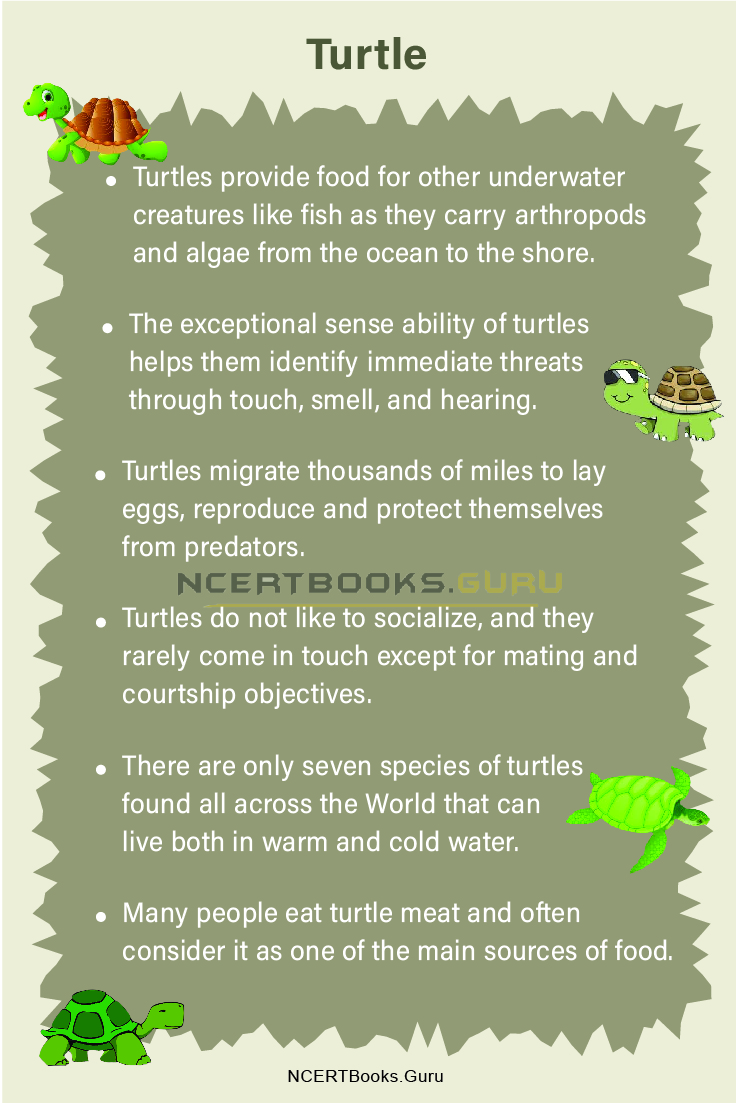10 Lines on Turtle: Turtles are primitive and one of the eldest group of reptiles that evolved millions of years ago. These reptiles have hard shells that protect them from any danger. They can survive in any climate. Hence, you will find them almost anywhere in the World. Since they exist even before nature, they play a huge role in controlling the underwater World’s biodiversity with the consumption of grass, seaweeds, and sponges. They also increase the production of nutrients in the sea bed. May 23rd is dedicated to the turtles and is known as “World Turtle Day”.
Today, many people pet freshwater turtles at home and believe in bringing good fortune. Red-eared sliders are one of the famous freshwater turtle pets. However, according to a research conducted by the World Wildlife, (WWL), it is observed that sea turtles are lowering down in number due to water pollution and wastes that are eventually hurting and killing them. Here we have assembled three sets of ten lines on turtles that will help you to get more information about turtles, their types, and behavior.
Enhance your vocabulary and writing skills with 10 Lines Essays available. Spark up the creativity in you and access various Topics on 10 Lines all in one place.
10 Lines on Turtle for Students and Children in English
The first set will help the students of classes 1, 2, 3, 4, and 5.
- Turtles belong to Testudines vertebrates and are the only replies found in any part of the World except Antarctica.
- After fish, the most common animal that you will find in the ocean is turtles.
- Including the groups of terrapins and tortoises, more than three hundred turtles species exist in the World with various shapes, sizes, and colors.
- Although a turtle’s average lifespan is eighty years, some of the turtles manage to live for more than a hundred years.
- The average length of a turtle is between 6cm to 2metres, while the weight varies between ten to seven hundred kilograms.
- Turtles look for beaches across the World to lay eggs, dig a hole in the sand and cover it for protection.
- The turtles look for tropical and subtropical beaches which indicates that they are cold-blooded animals.
- A female turtle can lay ninety to one hundred and ninety eggs at a time.
- The shield of turtles acts as protection against their vital organs and saves them from predators.
- Most turtles are omnivorous. However, some species of turtles are said to be herbivores and carnivores as well.

Set 2 – 10 Lines on Turtle for School Children
The second set will help the students of classes 6, 7, and 8.
- Turtles provide food for other underwater creatures like fish as they carry arthropods and algae from the ocean to the shore.
- Turtles are sensitive to red color and have great vision.
- The exceptional sense ability of turtles helps them identify immediate threats through touch, smell, and hearing.
- The heavy shell in the back of turtles makes them slow.
- Turtles migrate thousands of miles to lay eggs, reproduce and protect themselves from predators.
- Turtles do not like to socialize, and they rarely come in touch except for mating and courtship objectives.
- There are only seven species of turtles found all across the World that can live both in warm and cold water.
- The hunting and poaching of turtles have left them at risk of cessation.
- Many people eat turtle meat and often consider it as one of the main sources of food.
- Turtles’ fat is used as an important ingredient to make cosmetic products, and the turtle shell holds medicinal importance in China.
Set 3 – 10 Lines on Turtle for Higher Class Students
The third set will help the students of classes 9, 10, 11, and 12.
- Turtles spend most of their lives underwater as the streamlined body and webbed feet help them survive underwater.
- Seawater turtles do not leave the ocean except for laying eggs in the shorelines, while the freshwater turtles that live in ponds climb out of the water on logs or rocks to bathe under the Sun.
- The turtles are also land animals and have stumpy and round legs which help them to walk.
- The turtles can dig holes deep into the ground and hide under when the Sun’s scorching heat gets too hot.
- Terrapins are a species of turtles that live in both land and water, especially in lakes, ponds, swamps, and rivers.
- According to the World Wildlife Federation, the leatherback turtle is the largest turtles species that weighs from 250-678grams and is 5.25feet in length.
- The coral triangle of the Philippines, Indonesia, Malaysia, coasts of East Africa, Galapagos Islands, and the Gulf of California is the home of sea turtles.
- According to Animal Planet, the most common turtle found in Africa is the African helmeted turtle.
- These turtles eat small mammals and young birds and its life is nothing less than a scavenger hunt.
- The African helmeted turtles release a bad smell from its glands present in their legs.

Many people pet freshwater turtles in their house. Turtles are like humans best friend. However, they do not like to socialise. There are various species of turtles found around the World. However, the five main species are hawksbill, loggerhead, leatherback, green and olive ridley. The turtles are slowly running towards extinction, especially with the humans’ slaughtering for their shells, meat and skin. To prevent such practices, the government in various countries has made turtle killing and keeping them as a pet at home illegal. World Wildlife is trying their best to save the sea turtles from extinction.
Frequently Asked Questions on Turtle
Question 1.
Where do you find the Roti Island Snake Turtles?
Answer:
According to a zoo in San Diego, the Roti Island Snake Turtles are found only on the sixty-two square kilometres of Indonesia’s Roti Island.
Question 2.
What is the turtle’s shell made up of?
Answer:
According to Animal Diversity Web, of the Michigan University, the shell of a turtle is a modified ribcage which is a part of it’s the vertebral column.
Question 3.
Do turtles make a sound?
Answer:
Yes! Turtles make noises like belching humans, or electric motors, some even bark like dogs. Did you know that a South American red-footed tortoise clucks like a chicken?
